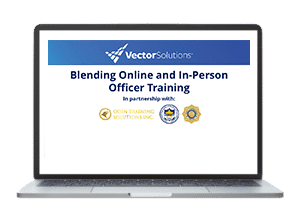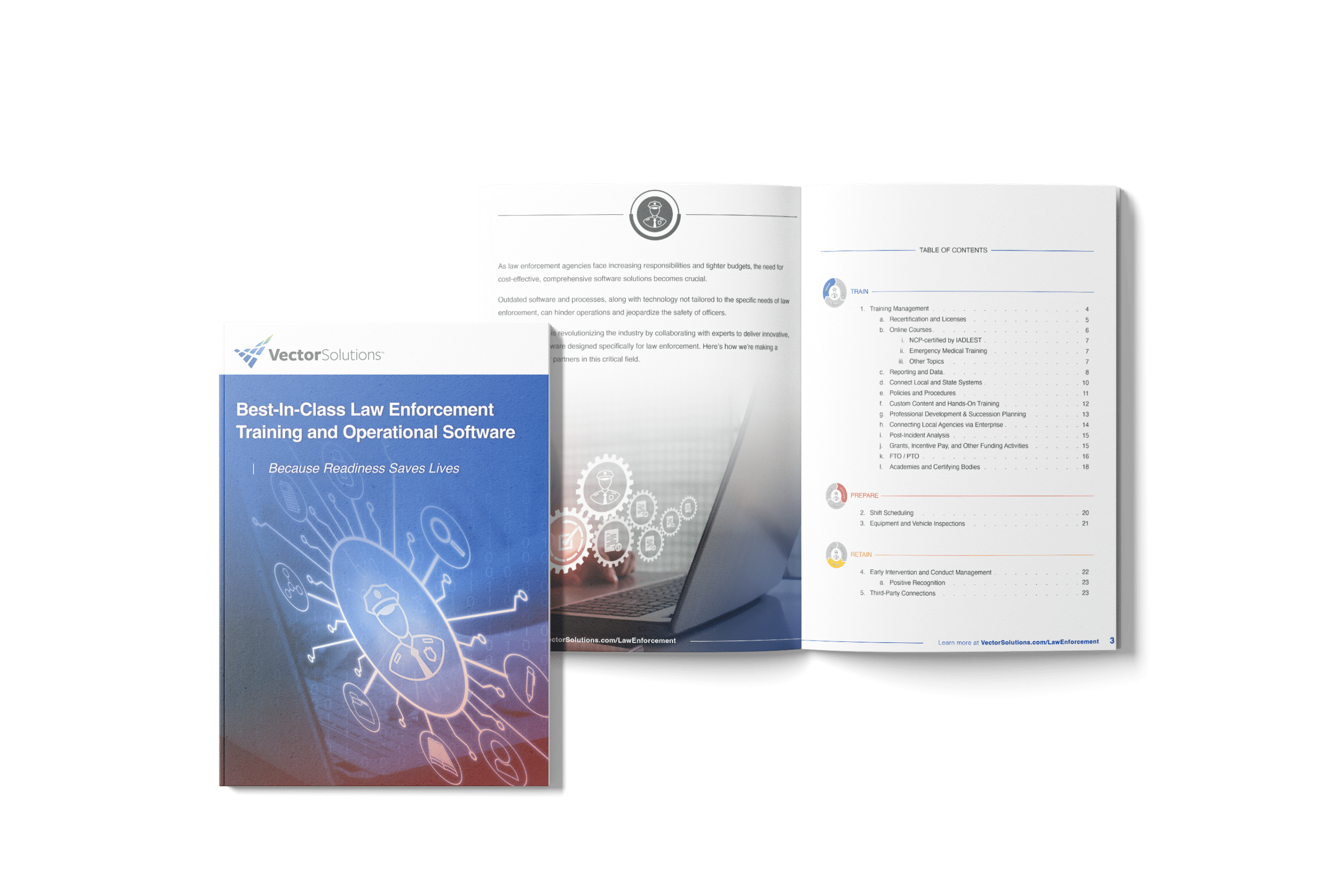October 21, 2024 8 min read

How to Build Effective Blended Training Programs for Law Enforcement
Industry:
Solution:

Technological advancements are significantly transforming both the daily operations of law enforcement and the methods used in their training. In a recent webinar series, Vector Solutions has teamed up with industry experts to explore cutting-edge training technologies now available to law enforcement agencies and how to implement them effectively. Our first webinar focused on the use of online training and our second shared insights related to the use of virtual reality as a training tool.
In our third webinar of this four-part series– “Empowering Today’s Officers: Blending Online and In-Person Officer Training” –we discussed how to create effective blended training programs and the benefits they offer.
Presented by Vector Solutions, the discussion was moderated by ret. Sgt. Doug Kazensky, Senior Solutions Engineer at Vector Solutions and featured Dianne Beer-Maxwell, a Project Manager at the International Association of Directors of Law Enforcement Standards and Training (IADLEST) and Kerry Avery, CEO of Odin Training Solutions, Inc.
Empowering Today's Officers: Blending Online and In-Person Officer Training
Watch On-Demand
What is blended training?
Despite the frequency that “blended training” is talked about, the exact definition can be somewhat nebulous depending on the context and the individual using it. As shared by Avery, the meaning has also shifted over time.
“Early on, people thought blended learning was just the incorporation of technology into the classroom,” she said. “Today, blended learning is the combination of online and classroom components for a single course. We look at online delivery, classroom delivery…and combining them both into one.”
Kazensky agreed, saying that much has changed over the last several decades.
“Back in my day, blended learning was when we would watch a VHS tape and then practice what we saw on the mat,” he said.
As technology and the definition of what is truly a “blended” training model has evolved, what are the hallmarks of a blended training model today?
- The training is designed as a single course, not the “online” section and the “in-person” section
- The two delivery methods work together and are not siloed
- The use of multiple delivery methods enhances training and lays the groundwork for the topic
- The training delivered online is completed independently, and is not just a livestream or recording of a classroom-based training course
In those cases when blended training is implemented without the above points taken into consideration, it often results in suboptimal experiences for both trainees and training officers.
“Plenty of people have been burned by negative experiences. Saying ‘we tried it out and it was a big disaster…and so, we just want to stay away from it because we feel like it’s not effective,’” Beer-Maxwell said. “I think that’s a really missed opportunity because we know now that there is a way to do [blended training] well and that it can be effective. We have the data that shows us that it can be effective.”
What benefits do blended training programs offer?
Beyond just keeping up with constantly evolving best practices and new training mandates, law enforcement agencies must also carefully balance the amount of time spent on training activities with the day-to-day responsibilities of officers. Staffing shortages, increased public scrutiny, and budget challenges can all make finding that perfect ratio even more difficult.
“There’s this push and pull of needing to hurry up and get officers back out onto the street or into their duty roles and assignments, and yet we also need them to be competent at a vast amount of skill and knowledge,” Beer-Maxwell said. “Blended learning can help create a little space, a little bit of breathing room…to maximize the time you have and to help increase the returns on your investment in training and education.”
According to the Academy Innovations research study conducted by Beer-Maxwell and her team for IADLEST, utilizing online training provides significant time savings with only a nominal impact to testing scores.
The study utilized a total of four test groups and examined whether traditional instruction or an integrated approach, where students received supplemental instruction over a period of intervals, was more effective at helping officers retain knowledge over time. Additionally, of the four groups, two received only in-person classroom instruction and the other two received initial in-person instruction and then were also provided supplemental instruction online.
“The [students] that got online training as their supplemental instruction were able to complete the same amount of content in a significantly shorter amount of time than the people who were in the in-person lecture experience,” she said.
At the end of the study, the students who received all instruction in-person did have higher test scores than the students who received part of the instruction online, however, the difference in scores only amounts to about 10 points between the two.
“If I didn’t have to spend 24 hours in my classroom and I only had to spend eight hours…what would I do with that extra time? Every trainer I have spoken with says [they] would spend that extra time doing practical exercises, working on scenarios, working on application, because that is where things get sticky,” she said.
In addition to saving time and allowing agencies and academies to reinvest training hours into other important areas, incorporating online training and creating a blended learning model also allows students to work at their own pace and more easily review training content later on to ensure knowledge and skills are retained.
“When we look at the statistics of how long it takes people to finish a module, sometimes there’s a huge range. Some people finish in less than and hour and some people take three hours,” Avery said, adding that she often hears from her law enforcement customers that they love the ability to work at their own pace.
How can agencies make sure blended training is effective?
Despite all the advantages blended training offers, there are some challenges that agencies and academies should be prepared to address if they choose to incorporate it. These challenges tend to stem from the commonly held belief that online training isn’t as “important” as in-person training. As a result of this belief, it can be treated as an afterthought, or something can be “fit in” between calls or even while off-shift.
According to Avery, negative outcomes of this attitude toward online training include:
- Limited retention of information. Just like with training offered in person, officers need uninterrupted, dedicated time to learn and focus.
- Low morale. Officers who are required to train during their off hours may have lower morale. All time spent on the job could be compensated, including training.
“We can’t have people trying to learn in 10-minute chunks between answering calls, writing reports, and everything else,” she said. “Some of the agencies I work with will actually pay for [training time]…but expect you to do it on your own time. Which seems to make people the happiest because they’d rather do it at home, in their own time and when it’s quiet instead of trying to do it in between [other tasks.]”
She would like to see more support for scheduling officers for dedicated online training activities, just like what would be done for in-person training, Avery said.
However, even when that ideal isn’t feasible, whether due to scheduling challenges, staffing shortages, or budget, incorporating online training through a blended learning model provides agencies with the flexibility they need to meet training requirements and ensure officers have the training they need to be successful.
To ensure those goals are met, agencies and academies should ensure key components of an effective blended training program are met:
- Blended training should reflect the overall goals of your training program. Think carefully about what can be moved online and what should stay in the classroom.
- The online training content is modern and reflect current policing best practices
- The online and in-person training should work in tandem to educate students on one topic
- Officers should be provided with a adequate amount of uninterrupted time for online training activities
- Classroom time should be used to conduct practical exercises
How can technology support blended training models?
It’s clear that blended training can provide significant benefits to law enforcement academies and agencies, but it can feel like a challenge to get off the ground. Thankfully, today’s agencies have the advantage of comprehensive, digital tools built with law enforcement in mind. More specifically, the use of training management systems (TMS) can dramatically streamline and simplify delivering, tracking, and reporting on any and all activities incorporated into a blended training program.
When selecting a technology company to partner with, look for vendors that are experience in providing training to law enforcement, have courses certified or approved by your state’s POST or a nationally recognized organization like IADLEST, and provide solutions purpose-built for law enforcement.
Learn more about the use of technology in law enforcement training programs
For insights on designing online training programs for law enforcement, watch, “Effectively Design Online Training Programs for Law Enforcement,” on-demand, featuring Alvin Sowers, Associate Director at KLETC and John Jacobs, Training Manager at Utah POST

For insights on the use of virtual reality for law enforcement officers, watch, “Utilizing Virtual Reality for Immersive Officer Training Experiences,” on-demand, featuring Lon Bartel from VirTra, a company that specializes in the use of VR for law enforcement simulation training.

For information on technology to streamline processes, register for “Technology That Will Help Your Agency Move Away From Manual Processes,” hosted live on October 30th, 2024 and featuring Lt. Eric Benson of Portsmouth Police Department and Sgt. Thomas Assion of Mahoning County Sheriff’s Office.
Register Now For “Technology That Will Help Your Agency Move Away From Manual Processes” on October 30th at 1pm ET
Vector Solutions’ suite of industry-leading software solutions for law enforcement includes training management systems, online training courses, FTO/PTO/CTO/live skill evaluations, academy automation, and an early intervention and conduct management system.











